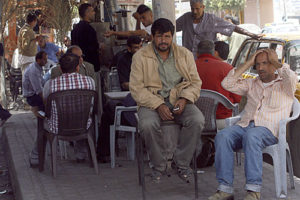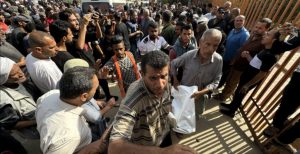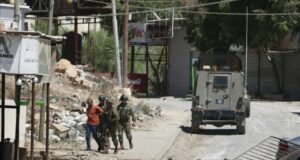
Unemployed Palestinians spend the day sitting in a cafe. As long as the economy in Gaza is not revived, unemployment will remain high and people will have little purchasing.
Bethlehem, 22 Rajab 1437/02 May 2016 (MINA) – As the world marks International Workers’ Day (May Day), laborers in the Palestinian territory continue to suffer from soaring unemployment, poverty, and other dire working conditions.
The average unemployment rate in the Palestinian territory was 26 percent in 2015: in the occupied West Bank, unemployment stood at 17 percent, compared to a staggering 41 percent in the besieged Gaza Strip, according to the Palestinian Central Bureau of Statistics (PCBS). Trade unions in the Gaza Strip estimate unemployment there has reached 60 percent, Ma’an was quoted by Mi’raj Islamic News Agency (MINA) as reporting.
PCBS estimates some 336,000 are unemployed in the West Bank, while 193,000 are unemployed in the Gaza Strip.
Participation of men in the Palestinian labor force was approximately four times higher than the participation of women in 2015. At a 60 percent unemployment rate, women in the Gaza Strip were the most vulnerable demographic across the Palestinian territory.
Also Read: Israeli Army Strikes Six Palestinians in Southern Gaza Amid Ongoing Tensions
Approximately 36 percent of wage employees in the private sector received less than the minimum wage in the Palestinian territory over 2015.
Workers in the southern occupied West Bank district of Hebron were particularly vulnerable to earning less than minimum wage, where the average monthly salary was 986 shekels ($263.75), compared to the minimum of 1,450 shekels ($387.85).
In the Gaza Strip, workers fared even worse, with an average monthly wage of 733 shekels ($196), as 67 percent of the workforce there earns less than minimum wage.
The majority of workers in the occupied Palestinian territory work without benefits — only 21 percent of wage employees received retirement or end of service benefits; while 22 percent received paid annual leave, 23 percent received paid annual sick leave, and 35 percent of female wage employees received paid maternity leave.
Also Read: Israeli Forces Continue Demolitions and Strikes in Gaza Despite Ceasefire
Debilitating poverty and lack of employment drives many workers in the occupied West Bank to enter Israel unlawfully by slipping through gaps in Israel’s separation wall, and risk being targeted by Israeli forces with rubber-coated steel bullets or live fire in the process.
B’Tselem spokesperson Sarit Michaeli told Ma’an in March that Israel’s continued occupation of the Palestinian territory and its effective crippling of the Palestinian economy meant it was “obligated to find ways to bring Palestinian laborers into Israel.”
PCBS estimates that in 2015 there were as many as 36,400 undocumented Palestinian workers, although most of these were employed in illegal settlements. (T/R07/R01)
Mi’raj Islamic News Agency (MINA)
Also Read: Hamas Returns Remains of Another Israeli Hostage Under Gaza Ceasefire Deal
































 Mina Indonesia
Mina Indonesia Mina Arabic
Mina Arabic